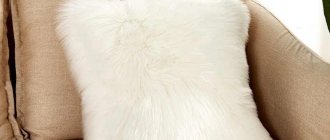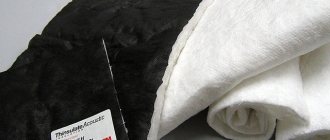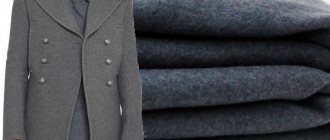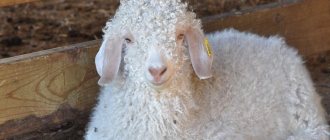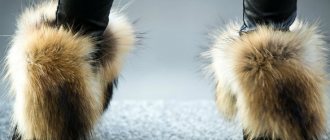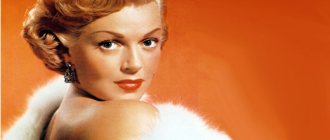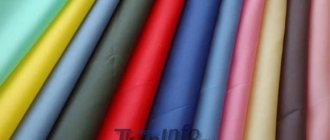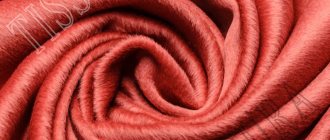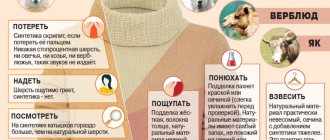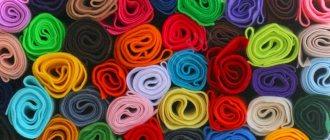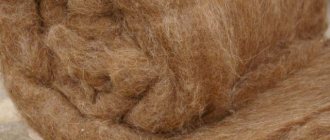Characteristics of material Pan
This material is sometimes called artificial wool, as it looks and feels just as soft and warm . Polyacrylonitrile - this is what the abbreviation "pan" means - is a synthetic material that is produced from natural gas by synthesizing fiber from acetylene and hydrocyanic acid.
The pan fiber production technology makes the thread continuous, which allows you to create fabrics that are absolutely even in structure and color. Sometimes it is cut into small pieces of equal length (staples), creating staple fabrics that resemble wool in appearance.
It is worth noting the color fastness of the material made from pan fibers, due to the fact that tinting occurs at the liquid stage, that is, the pigment is “diluted” in the fabric itself. Therefore, such things are not afraid of the sun's rays, water, or chemicals.
Among the advantages of the fabric we note the following:
- things made from this material hardly wrinkle, so they are ideal for traveling or at special events;
- good thermal insulation allows you to make clothes even for the winter season;
- are easy to wash and tolerate dry cleaning;
- can be repainted without problems and firmly hold the new color and photo printing;
- The hypoallergenic properties of the material allow it to be used for the manufacture of children's clothing, underwear, and home textiles.
However, there is, albeit a small, but still a fly in the ointment in this barrel of honey:
- pan does not allow air and water to pass through well, which is why such clothes have a “bath” effect;
- the material tends to accumulate static electricity;
- from friction of clothing parts against each other or “neighbors”, pellets are formed;
- fabric made from pan fibers easily absorbs grease, so such stains can be difficult to clean;
- When ironing with a hot iron, clothes may stretch.
Important! It is strictly forbidden to wash items made from pan fiber in water at temperatures above 30 degrees, as this leads to deformation of the product and gives it unpleasant rigidity. You can no longer wear such clothes.
What percentage of wool and other fabrics should a coat contain?
The question is not an easy one. Today, the market economy can provide the buyer with a huge variety of women's outerwear products. But
how big is the difference between price and quality?
Is it worth overpaying ? This article was created so that after reading you can buy the best coat for you, spending much less time and effort.
The main types of woolen fabrics used for sewing coats:
1. Tweed
is a dense but soft fabric with excellent thermal insulation from Scotland. Made from 100% natural sheep wool yarn. Often synthetic fibers are added to it to give the coat additional rigidity and wear resistance. The most common tweed colors: gray, white, brown.
Pros: pleasant to the body and to the touch; elegant; durable and lasts a long time; due to the type of plexus, it practically does not wrinkle and can recover itself after minor snags; slowly absorbs moisture.
Cons: a coat consisting of almost 100% tweed will cost a lot; Like any natural wool, it is susceptible to moth attacks.
Percentages: A tweed coat must contain at least 70% wool.
2. Cashmere
- soft, airy and tender. Produced in Scotland, Australia, New Zealand and others, but the best processing is done in Italy. The basis of production is fluff or undercoat, hand-plucked from a mountain goat. They are usually plucked out in the summer, when it gets warm, so don’t worry about the goats.
Cashmere is one of the most expensive types of fabrics, since only 150 grams can be collected from one animal, but for a coat you need about 1500-2000 grams.
Pros: light and delicate; wear-resistant, after good processing; thin, but retains heat perfectly; does not prick and is hypoallergenic.
Cons: requires careful care, hang only on a hanger and wash on a delicate cycle at 30 degrees; well-processed cashmere + its high content in the composition are very expensive.
Percentages: when buying a cashmere coat, be sure to check the label or ask the manufacturer what percentage of this material is contained, since often under the name “Cashmere coat” no more than 50% is hidden, but no less than 93% is required.
3. Drape
- the most common and famous type of fabric. Made from wool, the coat easily allows the addition of artificial fabrics due to the peculiarity of the structure of the cloth and its production by pressing and napping. Drape first appeared in France, during the industrial revolution. Needless to say now that draper is not afraid of either time or weather conditions.
Pros: elegance; excellent thermal insulation; density and wind protection; practicality and easy care; keeps its shape; affordability.
Cons: heavier than other fabrics; Pet hair gets sticky (you'll need a brush).
Percentages: a good drape coat contains at least 70% wool.
4. Angora
- soft and very warm, suitable for the harshest winters. Wool fabric is made from the down of the Angora goat or Angora rabbit. The natural color is white, gray, black, but can be easily painted. Feels close to silk. The best producers: France, Italy, Japan.
Pros: soft, light, pleasant to the body, very warm.
Cons: angora is a very complex material, it is very short-lived and wears out quickly, moreover, it does not tolerate moisture at all; he is eaten by moths; requires careful care.
Percentages: It is very difficult to say about the percentages in the composition of the coat; too delicate wool forces the use of a lot of artificial fabrics, and in production they often use rabbits rather than goats. If you decide to buy a coat made of Angora wool, we advise you to rely on the image and country of the manufacturer.
5. Viscose
- a material obtained from natural raw materials by artificial means. The creator is considered to be the French chemist and engineer Hilaire de Chardonnay, patented in 1892. Fabric is made from wood cellulose, then boiled in an alkali solution and then processed into the desired material, in our case fabric. As a result, viscose is soft and pleasant to the touch, and can also be easily dyed in any color.
Pros: beautiful appearance; pleasant sensations for the skin; hypoallergenic fabric; safe for the environment.
Cons: easily wrinkles; may shrink during normal washing; does not tolerate high temperatures.
Percentages: viscose goes well with woolen products and, in fact, is the same wool. In small volumes, up to 20%, it gives the coat additional elasticity and shine, but its content above 20%, although it noticeably reduces the cost of clothing, immediately exposes it to low wear resistance, easy creasing and the formation of pills.
6. Polyester
- the most common artificial fabric on the textile market, made from polyester fibers. The technology developed slowly, from 1941 in England, then it was modernized and became popular only in the 70s. Depending on the technology and quality of production, it can look like wool and even feel like silk or even be water-repellent.
Pros: does not wrinkle; keeps warm; resistant to external influences (light, high temperatures), therefore easy to wash; stain resistant; does not absorb odors; low price.
Cons: does not allow air to pass through; promotes sweating; accumulates electric charge (magnetized); cheap polyester can be allergenic.
Interest: high-quality polyester is an excellent material not only for lining coats, but also as an addition to wool. It makes it more elastic and dense, and also protects it from rain. However, do not forget that polyester in a coat is not wool, but just its addition, which should not exceed 20%.
Well, I hope you understand a little about what kind of coat and how much wool should contain. As we found out, bare percentages do not always speak comprehensively about the quality of a coat, since the same composition may use different animals or different processing and production technologies.
To buy a quality coat you need.
1.
Evaluate the appearance, quality of seams, touch.
2.
Look at the label and find out what kind of wool the material is made from and its percentage.
3.
It is advisable to go to the manufacturer’s website and find out about his image, where he gets the fabric from and its production technology.
In our store you can purchase an excellent drape coat from Moscow ]Avalon-fashion[/anchor]. A high-quality manufacturer of practical, stylish and inexpensive coats with which we have been working for many years!
© The article is the intellectual property of the online store “Rusia”, which is located on the domain name: “rusia-fashion.ru”
Copying violates the “Terms of Agreement”, as well as the federal law “On Information, Information Technologies and Information Protection”.
03.11.2018
A little about wool
Such a natural material as wool is very difficult to wear and care for, but despite this, it still remains a valuable raw material for making clothes for cool days and winter cold. Warm and cozy things made of wool do not allow you to freeze and at the same time easily allow moisture and air to pass through, so they are very comfortable. However, under unfavorable conditions, wool fibers become thinner and can break, causing the fabric to unravel and your favorite item to be thrown into the trash.
To make this happen less often, synthetic fibers like pan are added to wool, which give the product wear resistance and reduce its cost .
Who was the first to use merino wool in sportswear?
The potential of merino wool for sportswear was first seen by two enterprising people: in 1988, the German Gerald Kampel, a keen skier and founder of the Ortovox company, in 1994–1995, the New Zealander Jeremy Moon. One day, a fine merino wool T-shirt purchased from a local farmer inspired Jeremy to open his own clothing business, which later grew into Icebreaker.
What did Kampel, Moon, and after them dozens of other manufacturers of clothing for sports and outdoor activities see in merino wool?
Fine wool Australian Merino sheep
Pros and cons of the fabric composition “50 wool 50 pan”
In its pure form, pan is practically not used in everyday life and clothing, since the properties of this fiber do not give things the proper comfort . However, in a variety of combinations with natural materials (from 5 to 60%), in particular with wool, you can get excellent results. The 50/50 combination gives the canvas the following qualities:
- this fabric is almost wrinkle-resistant;
- products do not fade or shrink;
- the strength of natural material increases;
- things remain soft and pleasant to the touch;
- clothes are easy to wash and iron.
Important! You can iron things with pan only with a warm iron through a damp cloth.
Among the disadvantages, perhaps, one can note lower hygroscopicity compared to natural wool, accumulation of static electricity, although to a lesser extent than in pure synthetics, and the appearance of small pellets in places where parts of the item rub against each other. However, we have learned to deal with the last two problems quite successfully: the pellets are removed with a razor, tape or a special device, and antistatic agents will help get rid of electrical discharges .
Why are synthetics added to merino wool?
- The fine merino fiber is stronger than alpaca or cashmere, but is not as abrasion-resistant as quality synthetic fabrics, so it wears out faster. This does not mean that the clothes will become unusable after the first season, but if you want to get a more durable item, pay attention to products made from merino wool with the addition of polyamide, lyocell, and elastane.
- Merino fabric wicks away moisture well, but in this parameter it is inferior to quick-drying synthetics. During intense physical activity, especially in the heat, clothes made from merino will get wet faster and will take longer to dry than those made from synthetic fabric. Therefore, when doing aerobics or fast running, it is better to wear a suit made of synthetic sports fabric.
- Natural wool is more expensive than artificial fabrics. Many manufacturers, complementing natural clothing with inserts from other materials, reduce the price of it.
Review of popular brands of clothing made from merino wool
The quality of merino wool was appreciated by many brands of sportswear, but it was especially liked by manufacturers from the northern countries - Norway, Sweden, Denmark, Finland. The FiveSport catalog presents sportswear from several European brands.
Janus Wool Merino
Janus is a Norwegian company that produces a wide range of Janus Wool Merino thermal underwear for adults and children. The thin, tight-fitting silhouette and anatomical cut make it invisible under outerwear. The flatlock seams prevent chafing, and the elastic bands keep shirts and pants securely around the wrists and ankles. Thermal underwear is designed for temperatures down to −35 °C and is ideal for hiking, skiing, snowboarding, skating and winter jogging.
In addition to thermal underwear, Janus produces children's leggings, tights, dresses, turtlenecks, long sleeves, and multifunctional buffs from merino wool.
Janus thermogolf made of 100% merino wool - an excellent solution for winter training
Craft Merino
The Swedish brand Craft produces Craft Merino Lightweight thermal underwear, which combines the properties of merino wool and synthetic textile fiber lyocell. Thin mix material will keep the skin dry during running loads and will not allow you to freeze in 30-degree frost. The anatomical cut ensures an ergonomic fit of the product, and the raglan sleeve with an offset shoulder line does not restrict freedom of movement.
Thermal underwear of the Craft brand will be appreciated by lovers of hunting, fishing, cross-country skiing and other winter sports. The set will be completed with warm socks and a hat with merino wool from the same manufacturer.
Craft thermal underwear is worn by professional athletes
Brubeck Wool Merino
The Polish brand Brubeck produces very warm thermal underwear that provides warmth at temperatures down to −50 °C. The linen is two-layer: 78% merino wool, the rest is artificial fiber. In this set you can safely go to the mountains, winter fishing, hunting and even beyond the Arctic Circle. Among the features of the model are mesh inserts in areas of increased sweating.
Women's version of Brubeck Wool Merino thermal underwear
And another advantage of merino wool is that the fiber is 100% biodegradable. Products made from it do not need to be specially disposed of, unlike synthetic ones. Absolute benefit for people and for the planet on which they live.
